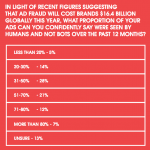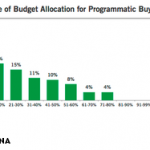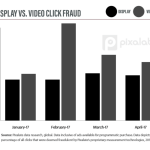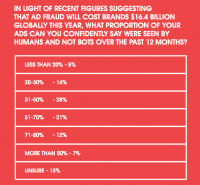the many Faces Of Programmatic advert Fraud
Columnist Ratko Vidakovic walks you during the more than a few forms of advert fraud to give you a greater working out of what entrepreneurs are up towards.

the subject of advertising fraud within the programmatic sector is a jugular issue concerning marketers these days. The openness that allows advertisers and publishers of any dimension to participate within the programmatic ecosystem also lets dangerous actors take part and pollute the quality of the sector.
Fraud is the first thing that a marketer must address when taking a look at the overall quality of their ad campaigns. it’s the basic first step earlier than looking to optimize for viewability or brand security, as a result of it basically poisons the whole thing else if left unchecked.
With recognize to sizing the impression of ad fraud, this excerpt from AdExchanger offers a guesstimate:
The affiliation of national Advertisers (ANA) and advert fraud solutions provider White Ops this month collaborated on a 60-day learn about looking at the severity of bots. The learn about tracked 181 campaigns amongst 36 ANA individuals (including Walmart, Johnson & Johnson and Kimberly-Clark) and decided that bots cause 23% of all video impressions, eleven% of display commercials and would account for $6.three billion in losses in 2015.
trade analysis pegs it reasonably high, however that’s having a look at this house in aggregate.
in accordance with data we see on our company’s platform, fraud varies greatly by using advert trade. Exchanges with terrible reputations for high quality have fraud in the 25–50 % range, whereas respected exchanges generally have less than 10 percent.
many of the trade dialogue around fraud, alternatively, only scratches the skin in a superficial approach and repeatedly conflates different issues beneath the huge label of “fraud.” Many discussions of fraud explain it in terms which are too simplistic and fail to underscore the nuances of this difficulty.
This piece focuses on the definition of fraud and the quite a lot of methods it takes shape.
Defining Fraud
It’s surprising how a lot disagreement and confusion there is round defining ad fraud. one of the most largest mistakes I see is the blanket definition of advert fraud as non-human (i.e., bot) visitors.
while that’s undoubtedly a attribute of some forms of advert fraud, to make it a criterion for outlining fraud is to leave out the bigger image: a major share of fraud is in reality human traffic, as we will be able to soon explore.
another way of fascinated about this common sense is as follows: whereas all bot traffic is certainly fraud, no longer all fraud is bot visitors — similar to fireplace is certainly hot, however not all scorching things are fireplace.
With that in mind, let’s take a look at a cultured definition. advert fraud has a number of of these traits:
• Non-human site visitors (i.e., bots).
• Zero likelihood of being viewed (i.e., zero percent viewability).
• deliberately misrepresented.
Most anti-fraud efforts, and most press coverage, seem to focus exclusively on non-human site visitors. but fraud goes a long way past bots. It also contains advertisements that have zero likelihood of being viewed with the aid of a human and ads which can be deliberately misrepresented via publishers.
Let’s start by means of in brief protecting each of those characteristics, starting with the non-human site visitors.
Non-Human visitors
Most non-human traffic is used to generate fake impressions (web page views) and fake clicks. In some cases, they go so far as to generate pretend type submissions, and subsequently, faux conversions.
• easy Bots: simple bots are essentially simply scripts that run from a server somewhere, like Amazon net services or some other web hosting provider. as a result of they are easy, they’re regularly easy to determine — due to the fact they have got a static IP, user agent, cookie identification and so on — which makes fingerprinting and blockading them relatively straightforward.
A easy have a look at some DSP public sale logs, or even net server logs from those that click on via, make simple bots fairly simple to become aware of and block. as an example, it is easy to merely block all recognized data center IPs.
• sophisticated Bots: subtle bots, alternatively, rent tactics like rotating user retailers, using random proxies (to rotate IP addresses), mimicking customary click-through charges, and in some instances, even mimicking real mouse actions from captured browser process. All of those components make it tougher to fingerprint and block them.
• Botnets: Botnets are normally a big array of personal (residential) computers which were compromised through bad actors. These actors have keep an eye on of these machines, using them for tasks like loading and clicking on advertisements, which generates legit-having a look, but ultimately pretend, impressions and clicks for advertisers.
Botnets are the hardest to discover and block, however they are also highly unlawful and, due to this fact, riskier for dangerous actors to set up. (to peer an exact demonstration of how an infected computer behaves as a bot, inspect this eye-opening video from the oldsters at critical advert Science.)
nevertheless, considering bots are programmable, they frequently exhibit patterns that make them detectable by means of excellent consultants. additionally they make for extra engaging headlines, in order that they generally obtain the lion’s share of media protection.
Human visitors
Human visitors, alternatively, is possibly much more sinister because the finish customers are actual, but the impressions (and in some cases, clicks) generated are fraudulent. since they are actual people, it can be tougher to become aware of with the aid of carriers which are best on the lookout for bots.
• Invisible advertisements: There are just a few fashionable ways in which fraudulent publishers “disguise” ads so that they fit the criterion of having “zero likelihood of being viewed” by using a human visitor.
the primary is known as “ad stacking” or “influence stacking,” which is principally hiding ads behind different ads. In such instances, the publisher is generating more than one impressions for a single web page view, however the only ad that’s visible is the highest one.
In a identical vein, invisible iFrames are in a different way of intentionally hiding commercials. by way of loading ads in unviewable (1 pixel by using 1 pixel) iFrames, an impact or multiple impressions are generated, with no chance of ever being viewed. Such tactics are reasonably straightforward to realize using off-the-shelf advert verification instruments like indispensable ad Science or Pixalate.
• Arbitrage: probably the most below-mentioned but insidious sorts of human-based totally visitors fraud is a type of arbitrage. it could possibly take many shapes and affect a couple of formats, akin to display and, most significantly, video.
In essence, the dangerous actors purchase site visitors for an awfully low cost and resell it for a multiple of the cost. for instance, a publisher may sell their stock for $5 CPM on average however is also buying questionable visitors to their site for a fraction of that cost.
• area Spoofing: within the RTB (actual-time bidding) ecosystem, publishers are every so often allowed to declare their own domain and the label of their site identification. Fraudulent publishers use this as a chance to misrepresent their stock. they’ll identify themselves as huffingtonpost.com, but in case you dig deeper, the real domain the advert was served on used to be different. In other instances, the ad-serving domain is spoofed within the bid request.
• web site Bundling: web page IDs are how stock is assessed in the RTB ecosystem. the way in which RTB used to be designed, each and every site id used to be purported to correlate to a single domain.
but in practice, many publishers and exchanges bundle complete networks of domains beneath single website online IDs. So an advertiser would possibly suppose they are buying abc.com however turn out with advertisements served on xyz.com.
This configuration occurs on the supply facet, which is outdoor the keep an eye on of DSPs (demand-facet systems). This falls under the “deliberately misrepresented” stock class.
• ad Injection: on account of browser toolbars and different spyware and adware plugins, advertisements can get injected and/or changed on any site, steadily with out the person or publisher noticing. This creates a situation where ad inventory may exhibit up as fb.com, as an instance, however is not any manner associated to fb’s exact advert stock.
after all, any facebook user may inform you that there are no 300×250 or 728×90 banner placements. but with ad injection, inventory will also be created on top rate web sites out of skinny air.
• Cookie Stuffing: The practice of cookie stuffing is nothing new to the arena of internet marketing. There had been some excessive-profile instances of cookie stuffing where it was used to maximize affiliate income.
Cookies are just as essential lately, as a result of they’re the mechanism by which a big a part of the programmatic ecosystem targets audiences. And with less expensive sources of web site visitors on the market, cookie stuffing to dilute or misrepresent target market target data is now a real factor.
It’s also worth noting that cookie stuffing can occur on both human and non-human visitors, so technically, it may fall into both category, and infrequently both.
• click on Farms: There are incentivized programs, regularly masked as “do business from home” or “earn money online” schemes, that pay actual people to click on ads and even fill out kinds, leading to valueless impressions, clicks and conversions.
considering these are actual individuals, it’s exhausting for many instrument vendors to seize these schemes, however they’re most without a doubt fraudulent task. (check up on this video to enjoy a just right parody of what these schemes look like.)
taking a look forward
Now that now we have a greater understanding of the various kinds of ad fraud, and the nuances between them, it raises some essential questions:
• Why does ad fraud exist in the first location?
• who’s responsible for advert fraud?
• How do marketers protect themselves towards fraud?
we can resolution all these questions and more in subsequent articles. additionally, if this matter pursuits you, I might be talking at advert:tech NYC on November four on “working out the many Faces of advert Fraud (and the way to protect yourself).”
right through that presentation, we will be able to go much deeper into why fraud exists, who is responsible for it, tips on how to deconstruct fraudulent publishers and easiest practices for shielding yourself as a marketer.
(special because of Ian Trider at Centro, and Ian Johnson at Cadreon, for their useful insights.)
Some opinions expressed in this article may be these of a visitor creator and not necessarily advertising Land. personnel authors are listed here.
(Some photography used below license from Shutterstock.com.)
advertising Land – internet advertising and marketing information, methods & tips
(125)














